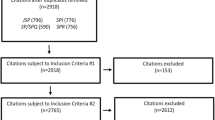Abstract
Horner and Sugai (2015) recently wrote a manuscript providing an overview of school-wide positive behavioral interventions and supports (PBIS) and why it is an example of applied behavior analysis at the scale of social importance. This paper will describe why school-wide PBIS is important to behavior analysts, how it helps promote applied behavior analysis in schools and other organizations, and how behavior analysts can use this framework to assist them in the promotion and implementation of applied behavior analysis at both at the school and organizational level, as well as, the classroom and individual level.
Similar content being viewed by others
References
Baer, D., Wolf, M., & Risley, T. (1968). Some current dimensions of applied behavior analysis. Journal of Applied Behavior Analysis, 1, 91–97.
Cooper, J. O., Heron, T. E., & Heward, W. L. (2007). Applied behavior analysis (2nd ed.). Upper Saddle River: Prentice Hall.
Drasgow, E., & Yell, M. (2001). Functional behavioral assessment: legal requirements and challenges. School Psychology Review, 30, 239–251.
Drasgow, E., Yell, M., Bradley, R., & Shriner, J. G. (1999). The IDEA amendments of 1997: a school-wide model for conducting functional behavioral assessments and developing behavior intervention plans. Education and Treatment of Children, 22, 244–266.
Dunlap, G., Carr, E., Horner, R., Zarcone, J., & Schwartz, I. (2008). Positive behavior support and applied behavior analysis: a familial alliance. Behavior Modification, 32, 682–698.
Dunlap, G., Iovannone, R., English, C., Kincaid, D., Wilson, K., Christiansen, K., & Strain, P. (2010). Prevent-teach-reinforce: a school-based model of individualized positive behavior support. Baltimore: Paul H. Brookes.
Horner, R. (2012). School-wide Positive Behavioral Interventions and Supports (SWPBIS): coaching for effective implementation. Retrieved April 4, 2015, from https://www.pbis.org/…/Coaching_Effecive Implementation. Kentucky. Pptx.
Horner, R.F. & Sugai, G. (2015). School-wide PBIS: an example of applied behavior analysis. Implemented at a scale of social importance. Behavior Analysis in Practice, 24 February 2015.
Individuals with Disability Education Act Amendments of 1997 [IDEA]. (1997). Retrieved from http://thomas.loc.gov/home/thomas.php
McDonnell, J.J., O’Keeffe, B., & O’Neill, R. E. (in press). Single case design and data-based decision-making. Individual positive behavior supports: a standards-based guide to practices in school and community-based settings. Baltimore, MD: Paul H. Brookes.
O’Neill, R. E., McDonnell, J. J., Billingsley, F. F., & Jenson, W. R. (2011). Single case research designs in educational and community settings. Upper Saddle River: Pearson.
PBIS Assessment. (n.d.). Retrieved April 4, 2015, from https://www.pbisapps.org/Applications/Pages/PBIS-Assessment.aspx.
Positive Behavioral Interventions and Supports. (n.d.). Retrieved April 4, 2015, from http://www.nea.org/assets/docs/PB41A-Positive_Behavioral_Interventions-Final.pdf.
Technical Assistance Center on Positive Behavioral Interventions and Supports. (2015). University of Oregon. Eugene. Retrieved April 4, 2015, from http://www.pbis.org/.
School Climate Transformation Grant - State Educational Agency Grants Program. (n.d.). Retrieved April 4, 2015, from http://www2.ed.gov/programs/schoolclimatesea/index.html.
Skinner, B. (1976). Walden Two. New York: Macmillan.
Special Education--State Personnel Development Grants Program. (n.d.). Retrieved April 4, 2015, from http://www2.ed.gov/programs/osepsig/index.html.
Sprague, J. R., Scheuermann, B., Wang, E., Nelson, C. M., Jolivette, K., & Vincent, C. (2013). Adopting and adapting PBIS for secure juvenile justice settings: lessons learned. Education and Treatment of Children, 36, 121–134.
SWIS Suite. (n.d.). Retrieved April 4, 2015, from https://app.swis.org/.
Author information
Authors and Affiliations
Corresponding author
Additional information
This research was supported by the Office of Special Education Programs US Department of Education (H326S980003). Opinions expressed herein are those of the authors and do not necessarily reflect the position of the US Department of Education, and such endorsements should not be inferred.
Rights and permissions
About this article
Cite this article
Putnam, R.F., Kincaid, D. School-Wide PBIS: Extending the Impact of Applied Behavior Analysis. Why is This Important to Behavior Analysts?. Behav Analysis Practice 8, 88–91 (2015). https://doi.org/10.1007/s40617-015-0055-2
Published:
Issue Date:
DOI: https://doi.org/10.1007/s40617-015-0055-2



